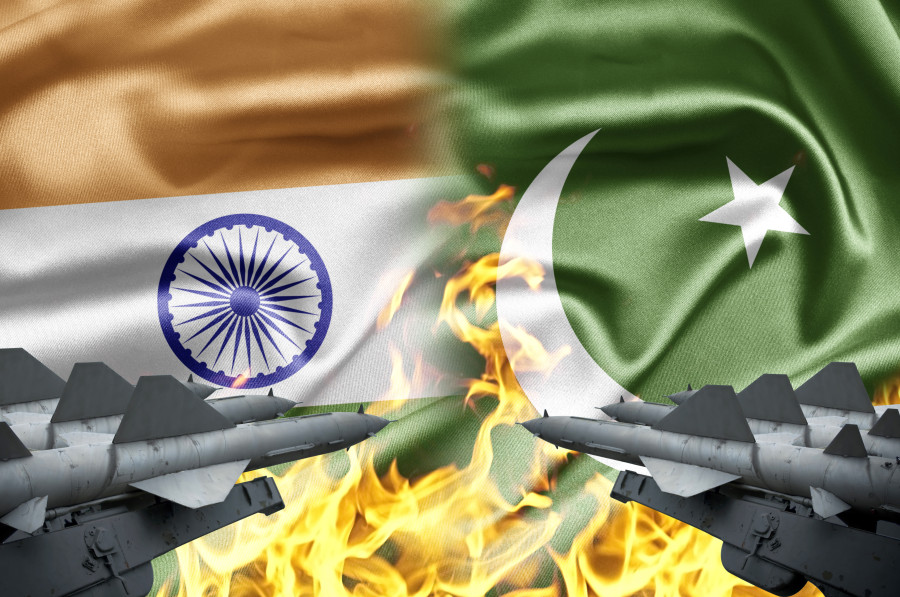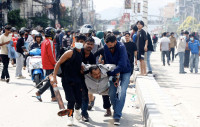Opinion
India vs Pakistan: When hashtag wars can be more frightening than real ones
The only response to the recent India-Pakistan conflict might be Kurt Vonnegut’s pithy refrain: so it goes
Amish Raj Mulmi
On Tuesday, I woke up to the reverberations of an air strike almost 1,000 km away. The Indian bombs may have fallen in Balakot, Pakistan (not Balakot in Pakistan-administered Kashmir, as Indian journalists helpfully tweeted), but surely everybody across the sane world could hear them, not least the unfortunate man whose sleep was broken by shrapnel shattering his windows. As the Pakistani armed forces representative tweeted the news of an Indian air strike inside Pakistan and journalists began to dig out more details, Indian journalists cheered their forces for euphemistically ‘bombing the shit out of’ their partitioned brother who has been an enemy their entire independent lives. A news anchor decided to wear combat fatigues and carry a toy gun to show the state of preparedness.
Sitting in Delhi, all I could think about was Kurt Vonnegut’s pithy response to war, death and destruction in the Second World War: So it goes.
On Wednesday, while those on the Indian side were cheering on their military forces for successfully escalating the Kashmir conflict into previously unheard-of territory, the Pakistani side decided they couldn’t let down their social media warriors either. Abbottabad was a one-off, Islamabad needed to show the world; so a whole group of aircraft whose initialled names one cannot always remember flew into the Indian side, tried to bomb some military installations, and on their way back, took down an Indian aircraft. That afternoon, the Pakistan prime minister spoke of the futility of war while a captured Indian pilot calmly sipped tea and answered questions about his marital status.
So it goes.
On Thursday, while I feared a mushroom cloud erupting over my head anytime soon, saner voices began to prevail. The warmongers of yesterday now turned to peaceniks. Pakistan played the moral victory card and decided to release the pilot. India tightened the screws by saying, ‘Sorry, no deal unless you show us you are more serious about terrorism’. For good measure, it told the world Pakistan had been a bad boy, attacking India with missiles it was not supposed to use, at least not in an offensive role. The acronym AMRAAM now entered our lexicon. Pakistan was undeterred. It wanted to press charges of ‘environmental terrorism’ against India, because the airstrikes destroyed 15 pine trees. "‘There has been serious environmental damage,’ the Pakistan climate change minister told Reuters. Bollywood, meanwhile, woke up to the commercial potential of the air strikes as producers rushed to register titles like ‘Pulwama: The Deadly Attack’. ‘Ek Aur Likho—Pulwama Attack Versus Surgical Strikes 2.0,’ a film producer said.
On Friday, as I sat in my dentist’s lounge nursing a painful tooth, the TV set played a news channel that displayed a countdown of hours since the Indian pilot’s capture. It had been 49 hours since the pilot fell into enemy territory. By the time the dentist had conducted her own surgical strike on my tooth, the countdown had climbed to 50 hours. The pilot returned safely by the evening, and no one would have been more relieved to see him return than the person responsible for the countdown. After all, the poor individual would have been counting the hours since Wednesday, and who could even say what time he crashed in Pakistan – ‘fog of war’ and such things. By evening, we were back to prime-time shouting matches, sobering editorials, and intra-family feuds on television.
So it goes.
The cliche that truth is the first casualty of war is nowhere starker than in the reports of casualty numbers from the Indian airstrike. The Indians first claimed a figure of approximately 300 terrorists, but the official announcement said a ‘very large number’ of terrorists. A Reuters report then dismissed these claims by saying only one person–the unfortunate man who was woken up by the bombs-–had been injured. Two separate digital forensic analysts broke down the airstrike using satellite imagery. One concluded, ‘Based on the available evidence—satellite imagery, official statements and reported leaks to the media—it appears plausible that India’s strikes in Pakistan were designed primarily to placate a domestic audience while simultaneously limiting escalation by not targeting built-up areas and causing substantial casualties.’ But even if the Jaish-e-Mohammed facility had been struck, would Pakistan release any numbers or inform the world of what had been going on in the training camp? In any case, the Indian Express reported Pakistani soldiers had evacuated JeM students after the air strike. What was left unsaid in the report, the ‘first direct account’ from the site, was the lack of any mention of any casualties. Another report added the air strike had hit four buildings inside the camp. There was imagery to prove it, but ‘limitations of technical intelligence and lack of ground intelligence’ leave the casualty number as ‘purely speculative’.
Undeterred, the BJP president announced 250 dead, even as the Indian Air Force chief said it does not have the exact numbers. ‘That statement will be made by the government, the air force is not in a position to clarify how many people were inside the target.’ Pakistan has refused to acknowledge these claims (if it did, it would also have to acknowledge the existence of a terrorist camp in Balakot). Even so, it has decided (finally) to clamp down on extremists within. ‘We are taking action in our national interest. We have to correct the course. We cannot leave this mess for our next generation,’ a government source told Dawn. There was scant mention of the international isolation Pakistan is facing over its perceived inaction on terror groups.
In India, the ruling party has moved from quoting numbers to saying ‘What the party president said must have been an estimation. The number could go higher also… We are not speculating on it. The important thing is that it was an effective strike.’ The focus, therefore, is not on casualties; instead, it’s on the ability to retaliate, at least that is what the narrative suggests. ‘No other leader in the world has such zero tolerance for terrorism,’ the BJP president has told voters.
So it goes.
Post-script: No government ready to go to polls within two months will waste the political mileage available from snubbing your enemy. Indian prime minister Narendra Modi made it clear his government will use the airstrikes as an election plank. ‘India is feeling the absence of Rafale,’ he said at a magazine’s conclave on Saturday, referring to the French aircraft whose purchase has landed the BJP government into allegations of corruption. While the opposition parties have sputtered and scrambled to come up with a response, it’s clear there’s little they have to offer apart from asking the BJP to not politicize the armed forces. But there’s little they can do when their own house is not in order.
On Sunday, PM Modi announced at a rally, ‘Instead of boosting the morale of our forces, [the opposition leaders] are speaking in a language which is lighting up the faces of our enemies.’ Either you are with us, or against us. Meanwhile, ordinary Kashmiris, like a dry fruit seller in Lucknow, are being hounded by Indian ‘nationalists’. India wants Kashmir, but doesn’t like Kashmiris, it seems.
So it goes.
Mulmi tweets at @amish973




 11.74°C Kathmandu
11.74°C Kathmandu










